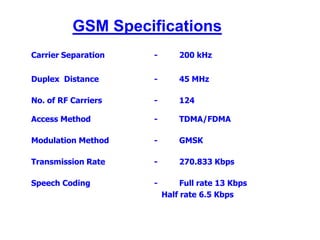4 Gsm Net Architecture Manish Copy Copy
- 1. GSM Network Architecture Presenter : Manish Kumawat All sections to appear here
- 2. Outline ŌĆó Introduction and history. ŌĆó GSM architecture. ŌĆó Implementation. ŌĆó Technology and standards. ŌĆó Summary
- 3. Introduction ŌĆó Global System for Mobile Communication (GSM) ŌĆō Anybody ŌĆō 500 million users (may 2001) ŌĆō Anywhere ŌĆō 168 countries (may 2001) ŌĆō Any media ŌĆō voice, messaging, data, multimedia Source: Hillebrand, 1
- 4. GSM Specifications Carrier Separation - 200 kHz Duplex Distance - 45 MHz No. of RF Carriers - 124 Access Method - TDMA/FDMA Modulation Method - GMSK Transmission Rate - 270.833 Kbps Speech Coding - Full rate 13 Kbps Half rate 6.5 Kbps
- 5. GSM FDMA (Frequency Division Multiple Access) 890 915 935 960 25 MHz 25 MHz 0 1 2 0 1 2 Mobile to Base Base to Mobile (MHz) 890.2 890.4 890.6 935.2 935.4 935.6 200 kHz 200 kHz 45MHz Channel layout and frequency bands of operation
- 6. GSM TDMA (Time Division Multiple Access) Amplitude 45 MHz 7 8 7 8 5 6 5 6 4 4 3 3 2 2 1 1 Frequency F1 F2 F1ŌĆÖ F2ŌĆÖ (Cell Rx) (Cell transmit) Typical TDMA/ FDMA frame structure
- 7. FDMA/TDMA Scheme TIME BP2 BP1 BP8 BURST BP7 F BP6 BP5 R BP4 A BP3 M BP2 E BP1 FREQ 890.2 890.6 891.0 890.0 890.4 890.8 891.2 915.8 MHz
- 8. GSM Architecture Home Location Register Network Management BTS = Base Transceiver Station Center AuC AuC = Authentication Center Equipment ID OMC = Operation and Maintenance Center PSTN = Public Switched Telephone Network ME = Mobile Equipment Visitor Location OMC Register Subscriber B Identity ME T Mobile S Module Data switching communication center network Subscriber B Base station Identity ME T Module S controller Subscriber B Identity ME T PSTN S Module Source: Stallings, 313 Source: Mehrotra, 27
- 9. GSM Architecture MS Transmission BS Transmission Band : 890 ŌĆō 915 Band : 935 ŌĆō 960 MHZ MHZ 45 MHz Year Introduced 1990 1 Access method TDMA 2 3 Channel Bandwidth 200 kHz 4 5 Number of duplex 125 6 channels 7 F1 F2 F1' F2' 8 Users per channel 8 Frequency Speech coding bit 13 kbps rate Data coding bit rate 12 kbps Frame size 4.6 ms
- 10. SIM (Subscriber Identity Module) Billions of Calls Millions of Subscribers Thousand of Different Types of Telephones Hundreds of Countries Dozens of ManufacturersŌĆ”. ŌĆóAdministrative data And only one Card: The SIM ŌĆóSecurity data ŌĆóSubscriber data ŌĆóRoaming data ŌĆóPLMN (Public Land Mobile Network Source: Hillebrand, 369 http://ucables.com/products/simcards/
- 11. Implementation Receiver >Channel Decoding Voice decoding >De-Interleaving Deciphering Demodulation >Re-formatting >Channel encoding >Interleaving Voice encoding Ciphering Modulation Amplifier >Burst generation Transmitter Central processor, clock and tone, internal bus system, keyboard (HMI) SIM = Subscriber Identity Module Source: Heine, 14
- 12. Implementation Slow frequency Transmission HF Transmitter Output filter TRX Abis- (HF-TX) Interface system hopping Digital signal HF Receiver processing (NF Input filter (HF-RX) functionality) O&M Module Operation and maintenance functionality/clock distribution Block Diagram of a BTS with one TRX Source: Heine, 20
- 13. GSM Variants Variant Uplink Downlink Total Duplex- Channels (MHz) (MHz) Bandwidth frequency GSM-400 451-458 and 461-468 and Twice 14 MHz 10 MHz Twice 72 479-486 489-496 GSM-900 890-915 935-960 Twice 25 MHz 45 MHz Twice 124 (primary band) Extended 880-915 925-960 Twice 35 MHz 45 MHz Twice 174 GSM-900 GSM-R 876-880 921-925 Twice 4 MHz 45 MHz Twice 19 DCS-1800 1,710-1,785 1,805-1,880 Twice 75 MHz 95 MHz Twice 373 PCS-1900 1,850-1,910 1,930-1,990 Twice 60 MHz 80 MHz Twice 300 Source: Bekkers, 299
- 14. References Bekkers, Rudi. Mobile Communications Standards: GSM, UMTS, TETRA, and ERMES. Norwood, MA: Artech House, Inc., 2001. Halonen, Romero, and Melero. GSM, GPRS, and EDGE Performance: Evolution Towards 3G/UMTS. England: John Wiley & Sons Ltd., 2003. Hillebrand, Friedhelm. GSM and UMTS: The Creation of Global Mobile Communications. England: John Wiley & Sons Ltd., 2002. Heine, Gunnar. GSM Networks: Protocols, Terminology, and Implementation. Norwood, MA: Artech House, Inc., 1999. Mehrotra, Asha. GSM System Engineering. Norwood, MA: Artech House, Inc., 1997. Harte, Levine, and Livingston. GSM Superphones. United States: APDG Publishing, Inc. A Division of McGraw-Hill, 1999.















